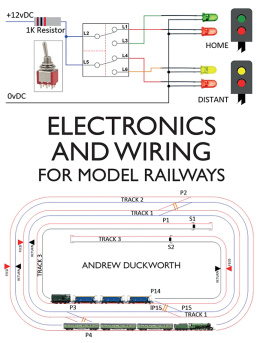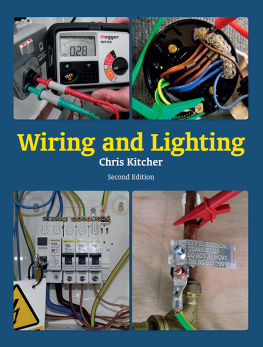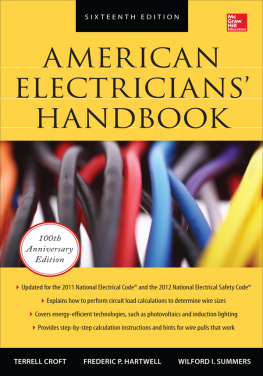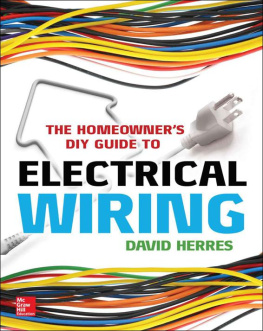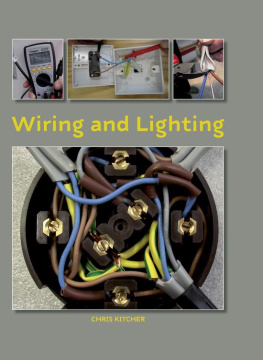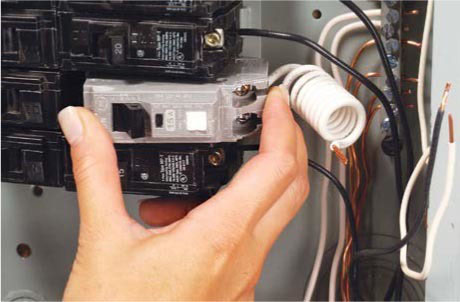ULTIMATE GUIDE
WIRING
8TH UPDATED EDITION
Technical Editor for Updated Edition: Charles T. Byers
Assistant Professor, Residential Remodeling Technology, AAS, AST,
Thaddeus Stevens College of Technology
CREATIVE
COPYRIGHT 2001, 2004, 2007, 2010, 2017
This book may not be reproduced, either in part or in its entirety, in any form, by any means, without written permission from the publisher, with the exception of brief excerpts for purposes of radio, television, or published review. All rights, including the right of translation, are reserved. Note: Be sure to familiarize yourself with manufacturers instructions for tools, equipment, and materials before beginning a project. Although all possible measures have been taken to ensure the accuracy of the material presented, neither the author nor the publisher is liable in case of misinterpretation of directions, misapplication, or typographical error.
Creative Homeowner is a registered trademark of New Design Originals Corporation.
The designations National Electrical Code and NEC are registered trademarks of the National Fire Protection Agency.
ULTIMATE GUIDE: WIRING
WIRING WIRING WIRING
WIRING WIRING WIRING WIRING WIRING WIRING
WIRING WIRING
WIRING WIRING WIRING
WIRING WIRING
WIRING WIRING WIRING
WIRING WIRING WIRING WIRING
WIRING WIRING WIRING WIRING
WIRING WIRING WIRING
WIRING WIRING WIRING WIRING
WIRING WIRING WIRING WIRING WIRING
WIRING WIRING WIRING
WIRING WIRING
WIRING WIRING WIRING WIRING WIRING WIRING WIRING WIRING WIRING
WIRING WIRING WIRING
WIRING WIRING
UPDATED EDITION
EDITION EDITION EDITION EDITION EDITION EDITION EDITION EDITION EDITION EDITION EDITION EDITION EDITION EDITION EDITION
EDITION EDITION
EDITION EDITION
Ultimate Guide: Wiring, 8th updated Edition
Print ISBN 978-1-58011-787-6
eISBN: 978-1-60765-758-3
Creative Homeowner, is distributed
exclusively in North America by Fox Chapel Publishing Company, Inc.,
800-457-9112, 1970 Broad St., East Petersburg, PA 17520,
and in the United Kingdom by Grantham Book Service,
Trent Road, Grantham, Lincolnshire, NG31 7XQ.
Safety
Although the methods in this book have been reviewed for safety, it is not possible to overstate the importance of using the safest methods you can. What follows are reminderssome dos and donts of work safetyto use along with your common sense.
Always use caution, care, and good judgment when following the procedures described in this book.
Always be sure that the electrical setup is safe; be sure that no circuit is overloaded, and that all power tools and electrical outlets are properly grounded. Do not use power tools in wet locations.
Never modify a plug by bending or removing prongs. When prongs are bent, loose or missing, replace the entire device.
Dont use 3-prong-to-2-prong cord adapters to overcome ground connections.
Be sure all receptacles and electrical conductors are properly grounded.
If a plug prong breaks off in a receptacle, do not attempt to remove it. Turn off the circuit, and call a licensed electrician.
Be sure receptacles are mounted securely in their boxes and do not move when the plug is inserted. A loose receptacle can cause a short circuit.
Do not use loose receptacles or other faulty electrical equipment until it is repaired or replaced and inspected by a licensed electrician.
Replace all damaged electrical enclosures such as receptacle, switch, and junction boxes.
Use extension cords only when necessary, on a short-term basis; never use extension cords in place of permanent wiring.
Be sure all extension cords are properly sized and rated for the use intended.
Keep electrical cords away from areas where they may be stepped on, pinched between door jambs, or otherwise damaged.
Dont use appliance or extension cords that show signs of wear, such as frayed or dried sheathing or exposed wires.
Visually inspect all electrical equipment and appliances before use.
Never staple, nail, or otherwise attach an extension cord to any surface.
Always turn off tools and appliances before unplugging them.
Never unplug a tool or appliance by yanking on the cord; always remove the cord by the plug.
Always keep the area in front of your main panel clear and dry. Work on a rubber mat or dry board and maintain an unobstructed area of at least feet in front of the panel. The panel must be easily accessed.
Keep dust, lint, and other combustible materials away from electrical panels, receptacles, and appliances.
Keep electrical panel doors closed and latched when not in use.
Keep all electrical equipment away from any source of water unless it is rated for use in wet areas, such as a wet-dry shop vacuum.
Use ground-fault circuit interrupters (GFCIs) wherever possible. GFCIs are required in all wet, damp, or moist areas.
Limit use of receptacles to one appliance. If more than one appliance will be on a circuit, use an approved plug strip with a built-in circuit breaker.
Use proper lighting in areas where the risk of an electrical hazard is present and keep emergency backup lighting readily available.
Keep all energized parts of electrical circuits and equipment enclosed in approved cabinets and enclosures.
Use only tools that have double insulated casings.
Always be aware of the potential hazards when doing electrical work of any kind.
Be sure to use appropriate protective equipment when doing electrical work (safety glasses, insulated gloves, rubber mats, etc.).
Contents
Introduction
PART I: PROJECTS, IMPROVEMENTS, REPAIRS
CHAPTER ONE
WIRING METHODS
Basic Circuitry
Charting Circuits Designing a Kitchen Wiring Plan Calculating Ampacity
Basic Wiring
Height and Clearance Requirements Installing Electrical Boxes Preparing for Inspection Surface Wiring Running Cable through Framing Opening and Closing Walls
Receptacles
Duplex Receptacles High-Voltage Receptacles GFCI Receptacles
Switches
Single-Pole Switches Three-Way Switches Four-Way Switches Dimmer Switches
Plugs, Cords, and Sockets
Standard Plugs Light Sockets and Switches Multi-Socket Switches
New Circuits and Service Panels
CHAPTER TWO
LIGHTING
Lighting Types
Incandescent Lightbulb Burnout Fluorescent Energy-Saving Compact Fluorescent Lamps Quartz Halogen
Lighting Fixtures
Recessed Surface-Mounted Track Lighting Chandeliers Vanity Lighting Under-Cabinet Lighting Cable Lights
Indoor Lighting Design
Basic Fixture Types How Much Light Do You Need?


